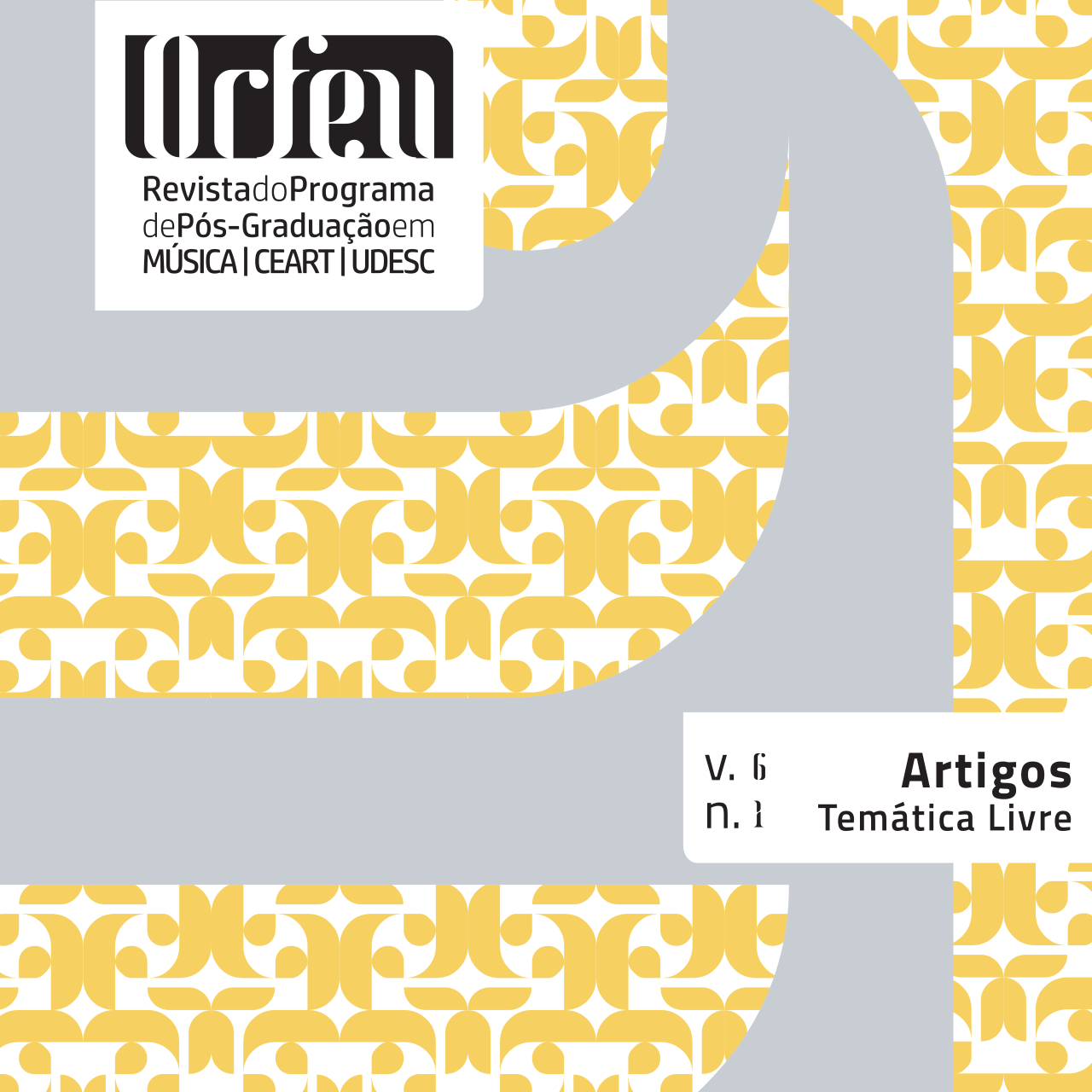Seven pillars of the piano technique
DOI:
https://doi.org/10.5965/2525530406012021e0001Keywords:
piano technique, corporal conscience, categories of healthy and efficient movementsAbstract
Piano technique has been widely discussed, and yet we are frequently confronted with outmoded beliefs concerning its dependence on factors such as natural talent, repetitive effort or hand size. The perpetuation of these antiquated notions can culminate in pain, injury, emotional problems, and even the definitive interruption of any artistic activity. This article aims to analyze and systematize approaches that strive for a healthy, rational and musical ways of thinking piano technique and categorize them into seven pillars: body posture, movement coordination, arm functions, including semi-circular and rotational ovements, lateral displacement on the keyboard and note grouping for enhanced cognition and technical mastery. It is concluded that, despite of small disagreements between the authors, there is a convergence in the search of pianistic efficacy through hysical well-being, translated into the development of body awareness and, consequently, in the quality and ariety of sound. The categorization of the pillars, in turn, promotes easier access to the analyzed concepts and allows greater efficiency in their application.
Downloads
References
BERNSTEIN, Seymour. With your two hands. New York: Schirmer Books, 1981.
BIENFAIT, Marcel. As bases da fisiologia da terapia manual. Trad.Angela Santos. 2. ed.
São Paulo: Summus, 2000.
BONPENSIERE, Luigi. New Pathways to Piano Technique. New York: Philosophical Library, 1953.
BREITHAUPT, Rudolf Maria. Natural Piano-Technique: School of Weight-Touch. 2. ed. Trad. John Bernhoff. Leipzig: C.F. Kahnt Nachfolger, 1909.
CHIANTORE, Luca. Historia de la técnica pianística. Madrid: Alianza, 2001.
DEPPE, Ludwig. Armleiden der Klavierspielen. Deutsche Musikerzeitung, p. 325, 1885.
FIELDEN, Thomas. The science of pianoforte technique. London: Macmillan and Co, 1949.
FINGER Use: Curling versus Curving - an excerpt from the Taubman 10 DVD Series. [S.l.: s. n.], 2008. 1 vídeo (1 min). Publicado pelo canal The Golandsky Institute. Disponível em: https://youtu.be/_ydx84Sp1rc. Acesso em: 17 jan. 2018.
FINK, Seymour. Mastering Piano Technique: A Guide for Students, Teachers, and Performers. Portland: Amadeus Press, 1992.
FRASER, Alan. The Craft of Piano Playing: A New Approach to Piano Technique. 2. ed. Lanham, Maryland: The Scarecrow Press, 2011.
GAT, Jozsef. The technique of piano playing. London: Collet’s, 1980.
GERIG, Reginald. Famous Pianists and Their Technique. 2. ed. Bloomington: Indiana
University Press, 2007.
KOCHEVITSKY, George. The Art of Piano Playing: A scientific approach. Miami: Summy-Bichard Company, 1967.
KOGAN, Grigory. Feruccio Busoni. Moscow: Compositores Soviéticos, 1971.
LISTER-SINK, Barbara. Let’s Get Physical: Técnica - uma conversa com Barbara Lister-Sink. [Entrevista cedida a] Scott McBride Smith. Keyboard Companion, v. 11, n. 1, Spring 2000.
LISTER-SINK, Barbara. Freeing the caged bird. Developing well-coordinated injury-preventive piano technique with Barbara Lister-Sink. Wingsound International, 2005. 1 DVD. Disponível em: www.freeingthecagedbird.com.
MARK, Thomas. What Every Pianist Needs to Know About the Body. Chicago: GIA Publications, 2003.
MATTHAY, Tobias. The act of touch in all its diversity: an analysis and synthesis of pianoforte tone-production. London: Longmans, Green and Co, 1903.
MATTHAY, Tobias. The Visible and Invisible in Pianoforte Technique. New York: Oxford University Press, 1932.
MATTHAY, Tobias. Piano fallacies of to-day. London: Oxford University Press, 1939.
MATTHAY, Tobias. The Visible and Invisible in Pianoforte Technique. 2. ed. New York: Oxford University Press, 1947.
MILANOVIC, Therese Elaine. Healthy virtuosity with the Taubman approach. APPCA Conference papper. Wagga Wagga: Charles Sturt University, 2011a.
MILANOVIC, Therese Elaine. The Taubman Approach to Piano Technique: What it is and What it isn’t. APPCA Conference paper. Wagga Wagga: Charles Sturt University, 2011b.
MILANOVIC, Therese Elaine. Learning and Teaching Healthy Piano Technique: Training as an Instructor in the Taubman Approach. Tese de doutorado. Queensland Conservatorium Arts, Education and Law. Brisbane: Griffith University, 2011c.
NEUHAUS, Henrich. The art of piano playing. Trad. K. A. Leibovich. Longwood Academic: Michigan University, 1973.
ORTMANN, Otto. The physiological mechanisms of piano technique. New York: Da Capo Press, 1929.
OSADA, Mayumi. The Lister-Sink method: A holistic approach to injury preventive piano technique. Thesis (PhD) – University of North Carolina, Greensboro, 2009.
SANDOR, Gyorgy. On piano playing: Motion, sound and expression. New York: Schirmer, 1981.
SAVSHINSKY, Samariy Ilich. O pianista e seu trabalho. Leningrado: Compositores Soviéticos, 1961.
SCHULTZ, Arnold. The riddle of the pianist’s finger and its relationship to a touch-scheme. Chicago: The University of Chicago Press, 1936.
TAUBMAN INSTITUTE. Choreography of the hands: The work of Dorothy Taubman. Amherst, MA: Sawmill River Productions, 1986. 1 vídeo, extensão mp4.
TAUBMAN INSTITUTE. The Taubman Techniques: An in-depth analysis of a technique for virtuosity and prevention of injuries among musicians. Medusa, NY: Taubman Institute, 1995. Vols. 1-5. 1 vídeo, extensão mp4.
TAUBMAN INSTITUTE. Virtuosity in a box: The Taubman techniques. Medusa, NY: Taubman Institute, 2003. Vols. 6-10. 1 vídeo, extensão mp4.
TIMAKIN, Evgeny Mikhailovich. Educação do pianista. Moscow: Compositores Soviéticos, 1984.
TORRES DEL RINCÓN, Marta. La escuela anatómico-fisiológica de técnica pianística en Inglaterra y Alemania entre 1900 y 1939. Tesis (Doctorado) – Universidad Autónoma de Madrid, 2017.
WHITESIDE, Abby. Indispensables of piano playing. New York: Charles Scribner’s Sons, 1955.
WHITESIDE, Abby. On Piano Playing. Indispensables of Piano Playing, and Mastering the Chopin Etudes and Other Essays, ed, Joseph Prostakoff and Sophia Rosoff. Portland: Amadeus Press, 1997.
Downloads
Published
How to Cite
Issue
Section
License
Copyright (c) 2021 ORFEU

This work is licensed under a Creative Commons Attribution 4.0 International License.
Authors who submit their manuscripts to be published in this journal agree to the following terms:
1. Authors retain the copyright and grant to the journal the right of first publication, whilst simultaneously permitting their work to be licensed under the Creative Commons License Attribution, which allows the sharing of work with recognition of the authorship and initial publication in this journal.
2. Contributions in this journal are open access; this means they are based in free use, and non-commercial applications.






